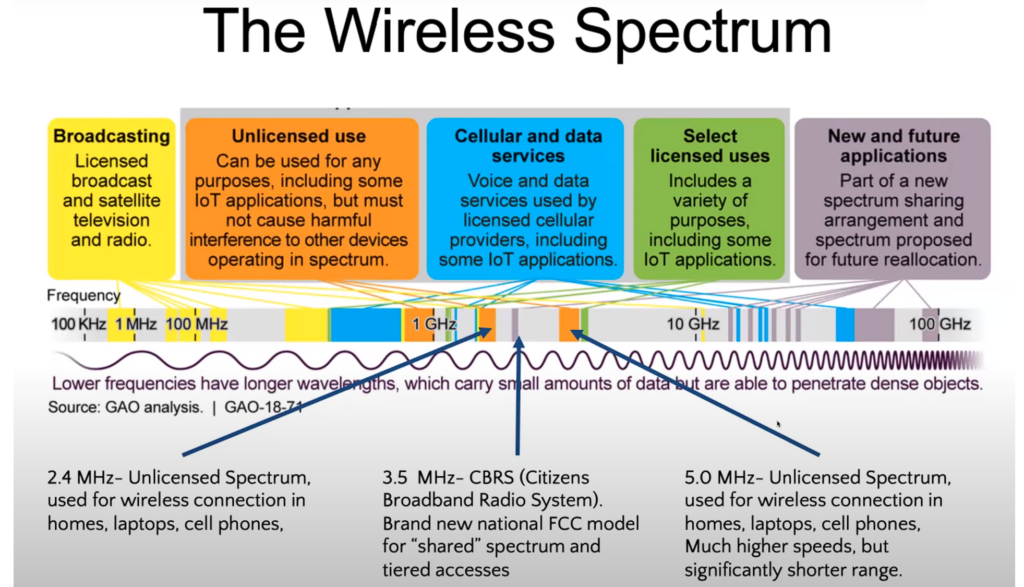The following is a recap of presentations by Tom Esselman, Executive Director at PCs for People Kansas City and Patrick McGuire, Technology Equity Manager at the City of South Bend given to the Kansas City Coalition for Digital Inclusion on May 5th, 2023. View a recording of this meeting on YouTube.
Background on the Citizens Broadband Radio Service (CBRS)
All forms of wireless communications – from radio and television all the way to Wi-Fi and mobile internet – work by sending information between devices using electromagnetic waves. Different technologies utilize different parts of the electromagnetic spectrum for transmitting signals. Radio and TV, for example, use waves with lower frequencies, which are better at transmitting information over long distances. In contrast, cell phone towers and Wi-Fi routers tend to use higher frequencies, as waves in these bands are better at transmitting large amounts of data quickly.
To ensure that wireless devices can communicate with each other without interference, the Federal Communications Commission (FCC) allocates specific frequency bands of the wireless spectrum to different users. An analogy would be a highway with different lanes reserved for different types of vehicles. Spectrum allocations can change over time as needs and utilization patterns shift. In October of 2020, the FCC opened up a new band of the wireless spectrum (3.55 – 3.70 GHz) that used to be exclusively reserved for military users. Now, internet service providers can offer wireless access using this band after paying a small fee. This allows them to set up towers and rooftop access points that beam a wireless signal to customers’ homes using these frequencies.
From the perspective of improving internet access, there are three primary benefits to CBRS. The first is capacity. Returning to the analogy of a highway, unlocking the CBRS frequencies is equivalent to dedicating more lanes to wireless internet. The additional capacity means that more households can be served by wireless providers without degrading network performance. The second benefit is cost. To use most frequency bands, providers first have to purchase expensive licenses. But because CBRS can be accessed for a small fee of $2.25 per user, internet service can be provided at lower cost. The final benefit is service quality. The frequencies in the CBRS band are better at penetrating obstacles than many of the other frequencies used by wireless providers, making it better for use in dense urban environments where network quality may otherwise be patchy and inconsistent.
In Kansas City, PCs for People utilizes CBRS to offer wireless internet service to underserved communities. PCs for People installs transmitters on towers and rooftops that are connected directly via fiber to an internet exchange point. These transmitters broadcast a wireless signal through the community, which clients can access by installing a modem in their home. PCs for People particularly focuses on families in affordable housing units and apartment buildings who often suffer from a lack of high quality broadband infrastructure.
South Bend
Outside of Kansas City, another community that has been leveraging CBRS is South Bend Indiana. During the early days of the pandemic, the city formed a partnership called Citywide Classroom to distribute hotspots to more than 5,000 students and their families to support remote schooling. While these hotspots helped address the immediate needs of households, it also made the city aware of the scale of need that existed within their community. In order to find a solution that would offer a more sustainable connectivity solution for South Bend, the city partnered with Notre Dame’s Wireless Institute to explore using CBRS and private LTE networks. The aim of this work was to create a city-wide network that could serve as an affordable connectivity solution for low-income families, enable free public Wi-Fi for residents, and support smart city initiatives.
The team selected Motorola Solutions as the vendor for their private network, and purchased 1,000 routers using money from the FCC’s Emergency Connectivity Fund (ECF). Installation was managed by the nonprofit enFocus, with the resulting network ultimately being owned and managed by South Bend’s school system.
The project began with the installation of three base stations, which was projected to serve 1,000 households across the city. Once the network was operational, however, the team discovered that its coverage footprint was significantly smaller than anticipated, largely due to interference from tree cover. In order to compensate, the team shifted the placement of their base stations to neighborhoods with a high density of low-income individuals, and began switching to high-powered antennas that could boost coverage. With these adjustments, the network is now expected to reach 2,200 eligible students once fully built. So far the team has distributed 210 routers to qualified families, who now have access to uncapped wireless internet with average speeds of around 70/20 Mbps.
South Bend is also working to utilize this network to expand the city’s public Wi-Fi, which is on pace to triple its coverage over the next two years and deliver wireless service to locations like a temporary housing location in the city that are difficult to serve with wired connections. The city is also beginning to explore the deployment of air quality, temperature, and other environmental sensors throughout the South Bend that would connect to the city’s private LTE network.

